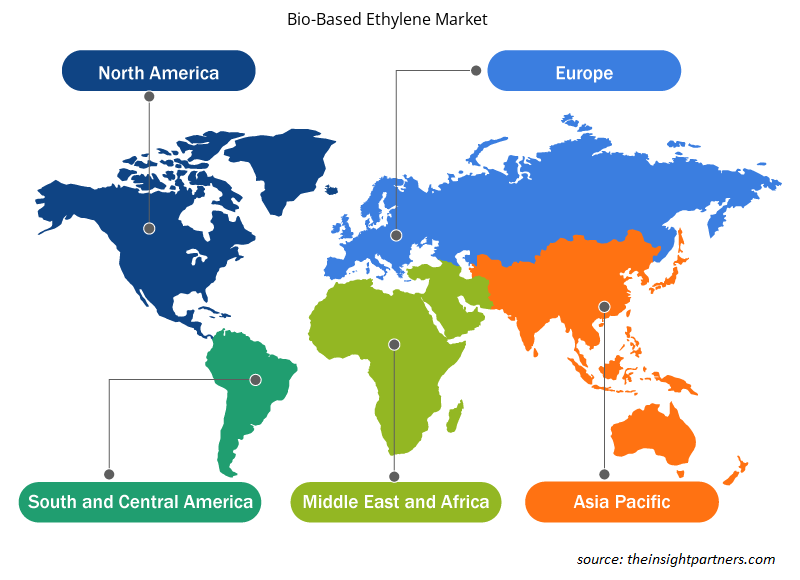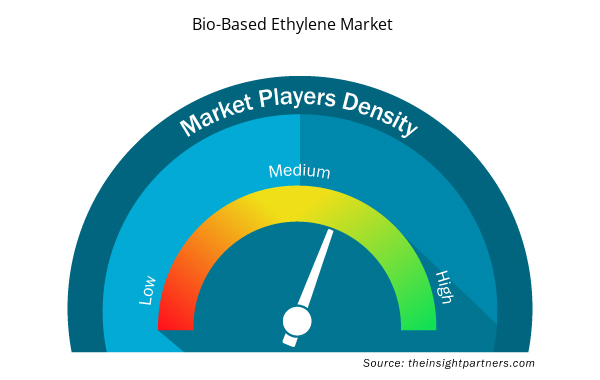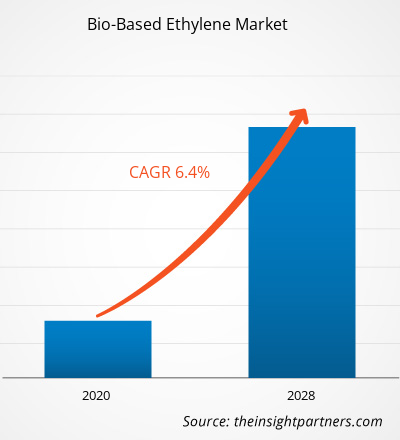2019 年生物基乙烯市场价值为 4.1434 亿美元,预计到 2028 年将达到 7.1832 亿美元,预测期内复合年增长率为 6.4%。
生物乙烯可由用于生物乙醇的生物质原料生产。生物乙烯现在广为人知,因为它被用作运输燃料。不同类型的自然资源,如糖(甘蔗、甜菜和甜高粱)、淀粉(玉米和小麦)和木质纤维素生物质(木材和草),在生产过程中用作原材料。生物乙烯在燃料添加剂、包装和洗涤剂生产制造商中越来越重要。寻求生物基材料的行业非常倾向于在其产品中使用生物乙烯。
2019 年,欧洲占据全球生物基乙烯市场的最大份额,预计北美在预测期内的复合年增长率最高。欧洲最大的市场份额主要归功于陶氏化学公司、Oxy Low Carbon Ventures (OCLV) 和 Enerkem 等主要制造商的存在。预计北美将在预测期内占据生物基乙烯市场的很大份额,这要归功于这种材料在该地区包装和塑料生产行业的广泛应用。生物乙烯由生物基材料制成,包括淀粉、糖和木质纤维素生物质。生物乙醇主要用作运输燃料的混合物,它在该地区的汽车工业中的重要性日益提高,这进一步影响了市场的增长。如今,居住在北美的人们甚至行业参与者都非常关注温室气体排放;因此,他们采用生物乙烯作为石化产品的替代品。这进一步为该地区的生物乙烯市场带来了积极的前景。
持续的疫情彻底改变了化学品和材料行业的现状,并对生物基乙烯市场的增长产生了负面影响。由于国家和国际边界突然关闭,COVID-19 疫情中断了运营效率并扰乱了价值链,造成了收入损失和损害。破坏性的价值链对原材料供应产生了负面影响,进而影响了生物基乙烯市场的增长。然而,随着各经济体计划恢复运营,全球对生物基乙烯的需求预计将上升。在疫情期间,由于消费者更喜欢在线订购商品,食品包装行业和消费品行业对生物基乙烯的需求正在上升。
此外,各国政府采取了积极措施,如部分封锁、旅行禁令等,以及分布式发电和先进技术的采用,这是另一个有望促进市场增长的因素。公司采取的安全措施包括限制与卡车司机和访客的直接接触、加强和传播适当的卫生习惯、进行全面卫生处理和消除换班期间的人员接触。考虑到所有这些因素,可以推测,在疫情后,一些应用领域对生物基乙烯的需求将大幅增加。
定制此报告以满足您的需求
您可以免费定制任何报告,包括本报告的部分内容、国家级分析、Excel 数据包,以及为初创企业和大学提供优惠和折扣
- 获取此报告的关键市场趋势。这个免费样品将包括数据分析,从市场趋势到估计和预测。
市场洞察
减少对化石燃料依赖的必要性
乙烯是许多下游化学产品的原料。它是最大的大宗化学品之一,广泛用于塑料生产。由于乙烯的广泛应用,其需求在未来几年可能会继续上升。传统上,乙烯是由石油衍生物制成的,这导致了化石燃料的枯竭。为了解决这个问题,生物质原料被认为是制造生物基乙烯的可靠替代品。生物乙烯是由生物乙醇生产的,生物乙醇广泛使用木质纤维素生物质,如木材、甘蔗和玉米淀粉,从而减少了对石油衍生物和化石燃料的依赖。利用当地资源生产的生物基产品也能够减少一个国家对化石燃料进口的依赖,从而刺激国内经济。
此外,生物基乙烯在生产和使用过程中都减少了温室气体排放。然而,生物乙烯的环境性能主要取决于生物乙醇生产的区域条件、土地使用变化引起的温室气体排放以及必要能源系统的条件。但是,生物基乙烯可以显著降低化学工业对环境的影响。因此,迫切需要减少对化石燃料的依赖,并提高对环境可持续性的认识,这些都推动了生物基乙烯市场的增长。生物基乙烯和石油基乙烯在化学上是相同的,因此,现有的生产能力和设备可以像往常一样用于生产其他下游产品,包括塑料,而不会对现有市场产生太大影响,这是支持市场增长的另一个因素。
原材料洞察
根据原材料,全球生物基乙烯市场细分为糖、淀粉和木质纤维素生物质。糖类部分在 2019 年占据了最大的市场份额。生物乙烯由生物乙醇生产,生物乙醇是一种广泛应用于运输领域的液体生物燃料。甘蔗中的糖是生产生物乙烯时利用率很高的原料,主要在印度和巴西。在巴西,由于廉价甘蔗原料供应广泛,生物乙烯的生产具有经济竞争力。甘蔗、甜菜和甜高粱很容易分解,因为蔗糖是一种二糖,可以利用酵母进一步直接发酵成生物乙醇。与石化生产相比,糖基生物乙烯生产估计可节省约 60% 的化石能源,因为该过程可以进一步发电。甘蔗基生物乙烯的生产成本也非常低。通过在石化行业中使用生物乙烯,还可以最大限度地减少使用化石燃料造成的温室气体排放。由于这些好处,大多数行业都在各种应用中采用生物乙烯。
最终用户行业洞察
就终端使用行业而言,全球生物基乙烯市场细分为包装、洗涤剂、润滑剂和添加剂。包装部门在 2019 年占据了最大的市场份额。生物基塑料或生物塑料由可再生生物资源生产。例如,甘蔗主要加工以制备乙烯,乙烯可进一步用于制造聚乙烯。淀粉也可以加工以提取乳酸和类似的聚乳酸 (PLA)。生物塑料的性质因材料而异。生物基或部分生物基耐用塑料,如 PE、PET 或 PVC,具有与传统塑料非常相似的特性。生物塑料,包括淀粉共混物、生物 PE、PLA 和生物 PET,主要用于包装应用。它们也用于纺织工业的纤维。从生物基材料中获得的琥珀酸非常适合包装和其他应用。由于石化产品造成的严重健康问题,客户对可分解聚合物的偏好日益增加,这是推动包装和纺织品应用产品需求的有利因素。
全球生物基乙烯市场的主要参与者包括 Braskem SA、陶氏化学公司、利安德巴塞尔工业控股公司、沙特基础工业公司和 Oxy Low Carbon Ventures (OCLV)。主要市场参与者专注于并购和产品发布等战略,以增加其全球地理影响力和消费者基础。例如,2021 年 4 月,Oxy Low Carbon Ventures 和一家名为 Cemvita Factory 的生物工程初创公司宣布建造和运营一座月产一公吨的生物乙烯试验工厂。这将通过使用联合先进的技术来实现,该技术利用二氧化碳 (CO2) 代替碳氢化合物来源的原料。
生物基乙烯市场区域洞察
Insight Partners 的分析师已详尽解释了预测期内影响生物基乙烯市场的区域趋势和因素。本节还讨论了北美、欧洲、亚太地区、中东和非洲以及南美和中美洲的生物基乙烯市场细分和地理位置。

- 获取生物基乙烯市场的区域特定数据
生物基乙烯市场报告范围
| 报告属性 | 细节 |
|---|---|
| 2019 年市场规模 | 4.1434亿美元 |
| 2028 年市场规模 | 7.1832亿美元 |
| 全球复合年增长率(2019 - 2028) | 6.4% |
| 史料 | 2017-2018 |
| 预测期 | 2020-2028 |
| 涵盖的领域 | 按原材料
|
| 覆盖地区和国家 | 北美
|
| 市场领导者和主要公司简介 |
|
生物基乙烯市场参与者密度:了解其对业务动态的影响
生物基乙烯市场正在快速增长,这得益于终端用户需求的不断增长,而这些需求又源于消费者偏好的不断变化、技术进步以及对产品优势的认识不断提高等因素。随着需求的增加,企业正在扩大其产品范围,进行创新以满足消费者的需求,并利用新兴趋势,从而进一步推动市场增长。
市场参与者密度是指在特定市场或行业内运营的企业或公司的分布情况。它表明相对于给定市场空间的规模或总市场价值,有多少竞争对手(市场参与者)存在于该市场空间中。
在生物基乙烯市场运营的主要公司有:
- 巴西石化公司
- 陶氏化学公司
- 利安德巴塞尔工业控股有限公司
- 沙特基础工业公司
- 能源公司
免责声明:上面列出的公司没有按照任何特定顺序排列。

- 了解生物基乙烯市场的主要参与者概况
报告亮点
- 全球生物基乙烯市场的渐进式行业趋势,帮助参与者制定有效的长期战略
- 发达市场和发展中市场采用的业务增长战略
- 2017 年至 2028 年市场定量分析
- 各行业对生物基乙烯的需求估计
- PEST 分析可说明行业内买家和供应商预测市场增长的有效性
- 了解竞争激烈的市场形势和对生物基乙烯的需求的最新发展
- 市场趋势和前景,以及推动和抑制生物基乙烯市场增长的因素
- 通过了解支撑全球生物基乙烯市场增长商业利益的战略来进行决策过程
- 生物基乙烯市场各节点规模
- 全球生物基乙烯市场的详细概述和细分以及其行业动态
- 各地区生物基乙烯市场规模及增长机遇
生物基乙烯市场(按原材料划分)
- 糖
- 淀粉
- 木质纤维素生物质
生物基乙烯市场(按最终用户行业划分)
- 包装
- 清洁剂
- 润滑剂
- 添加剂
公司简介
- 巴西石化公司
- 陶氏化学公司
- 利安德巴塞尔工业控股有限公司
- 沙特基础工业公司
- Oxy 低碳企业(OCLV)
- 历史分析(2 年)、基准年、预测(7 年)及复合年增长率
- PEST 和 SWOT 分析
- 市场规模价值/数量 - 全球、区域、国家
- 行业和竞争格局
- Excel 数据集


- Bio-Based Ethylene Market
- Semiconductor Metrology and Inspection Market
- E-Bike Market
- Small Internal Combustion Engine Market
- Health Economics and Outcome Research (HEOR) Services Market
- UV Curing System Market
- Adaptive Traffic Control System Market
- Data Center Cooling Market
- Vision Guided Robotics Software Market
- Mobile Phone Insurance Market

Report Coverage
Revenue forecast, Company Analysis, Industry landscape, Growth factors, and Trends

Segment Covered
This text is related
to segments covered.

Regional Scope
North America, Europe, Asia Pacific, Middle East & Africa, South & Central America

Country Scope
This text is related
to country scope.
常见问题
The major players operating in the global bio-based ethylene market are Braskem S.A., The Dow Chemical Company, LyondellBasell Industries Holdings B.V., SABIC, and Enerkem.
In 2020, Europe held the largest share of the global bio-based ethylene market. The largest market share of this region is primarily attributed to the presence of major manufacturers in the region. Also, the rising production activities of bio-based ethylene is expected to fuel the market growth during 2020–2028. Moreover, strict environmental regulations also promote the practice of producing biofuel and bio energy in the region. The increase in demand for alternative source of fossil fuel and growing demand for bi ethylene from plastic industry are further propels the growth of the bio-based ethylene market.
Bio-ethylene is produced from bioethanol, which is a liquid biofuel that is widely utilized in the transportation sector. Sugar from sugarcane is highly utilized raw material to produce bio ethylene mainly in India and Brazil. In Brazil, production of bio-ethylene is economically competitive owing to the wider availability of cheap sugarcane feedstock. Sugar from sugarcane, sugar beets, and sweet sorghum are quite easy to break down since the sucrose is a disaccharide, which can be further directly fermented into bio ethanol utilizing yeast. Sugar based bio-ethylene production is estimated to save about 60% of fossil energy as compared to petrochemical production since the process can further produce electricity. The production costs of sugarcane-based bio-ethylene is also very low. The greenhouse gas emissions caused for using fossil fuel can also be minimized while utilizing bio ethylene in petrochemicals industry. Due to these benefits, most of the industries are adopting bio ethylene for various applications.
Trends and growth analysis reports related to Chemicals and Materials : READ MORE..
The List of Companies - Bio-based Ethylene Market
- Braskem S.A.
- The Dow Chemical Company
- LyondellBasell Industries Holdings B.V.
- SABIC
- Enerkem
- Linde
- Shell Global
- TotalEnergies
- Axens
- Sigma-Aldrich
The Insight Partners performs research in 4 major stages: Data Collection & Secondary Research, Primary Research, Data Analysis and Data Triangulation & Final Review.
- Data Collection and Secondary Research:
As a market research and consulting firm operating from a decade, we have published and advised several client across the globe. First step for any study will start with an assessment of currently available data and insights from existing reports. Further, historical and current market information is collected from Investor Presentations, Annual Reports, SEC Filings, etc., and other information related to company’s performance and market positioning are gathered from Paid Databases (Factiva, Hoovers, and Reuters) and various other publications available in public domain.
Several associations trade associates, technical forums, institutes, societies and organization are accessed to gain technical as well as market related insights through their publications such as research papers, blogs and press releases related to the studies are referred to get cues about the market. Further, white papers, journals, magazines, and other news articles published in last 3 years are scrutinized and analyzed to understand the current market trends.
- Primary Research:
The primarily interview analysis comprise of data obtained from industry participants interview and answers to survey questions gathered by in-house primary team.
For primary research, interviews are conducted with industry experts/CEOs/Marketing Managers/VPs/Subject Matter Experts from both demand and supply side to get a 360-degree view of the market. The primary team conducts several interviews based on the complexity of the markets to understand the various market trends and dynamics which makes research more credible and precise.
A typical research interview fulfils the following functions:
- Provides first-hand information on the market size, market trends, growth trends, competitive landscape, and outlook
- Validates and strengthens in-house secondary research findings
- Develops the analysis team’s expertise and market understanding
Primary research involves email interactions and telephone interviews for each market, category, segment, and sub-segment across geographies. The participants who typically take part in such a process include, but are not limited to:
- Industry participants: VPs, business development managers, market intelligence managers and national sales managers
- Outside experts: Valuation experts, research analysts and key opinion leaders specializing in the electronics and semiconductor industry.
Below is the breakup of our primary respondents by company, designation, and region:

Once we receive the confirmation from primary research sources or primary respondents, we finalize the base year market estimation and forecast the data as per the macroeconomic and microeconomic factors assessed during data collection.
- Data Analysis:
Once data is validated through both secondary as well as primary respondents, we finalize the market estimations by hypothesis formulation and factor analysis at regional and country level.
- Macro-Economic Factor Analysis:
We analyse macroeconomic indicators such the gross domestic product (GDP), increase in the demand for goods and services across industries, technological advancement, regional economic growth, governmental policies, the influence of COVID-19, PEST analysis, and other aspects. This analysis aids in setting benchmarks for various nations/regions and approximating market splits. Additionally, the general trend of the aforementioned components aid in determining the market's development possibilities.
- Country Level Data:
Various factors that are especially aligned to the country are taken into account to determine the market size for a certain area and country, including the presence of vendors, such as headquarters and offices, the country's GDP, demand patterns, and industry growth. To comprehend the market dynamics for the nation, a number of growth variables, inhibitors, application areas, and current market trends are researched. The aforementioned elements aid in determining the country's overall market's growth potential.
- Company Profile:
The “Table of Contents” is formulated by listing and analyzing more than 25 - 30 companies operating in the market ecosystem across geographies. However, we profile only 10 companies as a standard practice in our syndicate reports. These 10 companies comprise leading, emerging, and regional players. Nonetheless, our analysis is not restricted to the 10 listed companies, we also analyze other companies present in the market to develop a holistic view and understand the prevailing trends. The “Company Profiles” section in the report covers key facts, business description, products & services, financial information, SWOT analysis, and key developments. The financial information presented is extracted from the annual reports and official documents of the publicly listed companies. Upon collecting the information for the sections of respective companies, we verify them via various primary sources and then compile the data in respective company profiles. The company level information helps us in deriving the base number as well as in forecasting the market size.
- Developing Base Number:
Aggregation of sales statistics (2020-2022) and macro-economic factor, and other secondary and primary research insights are utilized to arrive at base number and related market shares for 2022. The data gaps are identified in this step and relevant market data is analyzed, collected from paid primary interviews or databases. On finalizing the base year market size, forecasts are developed on the basis of macro-economic, industry and market growth factors and company level analysis.
- Data Triangulation and Final Review:
The market findings and base year market size calculations are validated from supply as well as demand side. Demand side validations are based on macro-economic factor analysis and benchmarks for respective regions and countries. In case of supply side validations, revenues of major companies are estimated (in case not available) based on industry benchmark, approximate number of employees, product portfolio, and primary interviews revenues are gathered. Further revenue from target product/service segment is assessed to avoid overshooting of market statistics. In case of heavy deviations between supply and demand side values, all thes steps are repeated to achieve synchronization.
We follow an iterative model, wherein we share our research findings with Subject Matter Experts (SME’s) and Key Opinion Leaders (KOLs) until consensus view of the market is not formulated – this model negates any drastic deviation in the opinions of experts. Only validated and universally acceptable research findings are quoted in our reports.
We have important check points that we use to validate our research findings – which we call – data triangulation, where we validate the information, we generate from secondary sources with primary interviews and then we re-validate with our internal data bases and Subject matter experts. This comprehensive model enables us to deliver high quality, reliable data in shortest possible time.


 获取此报告的免费样本
获取此报告的免费样本